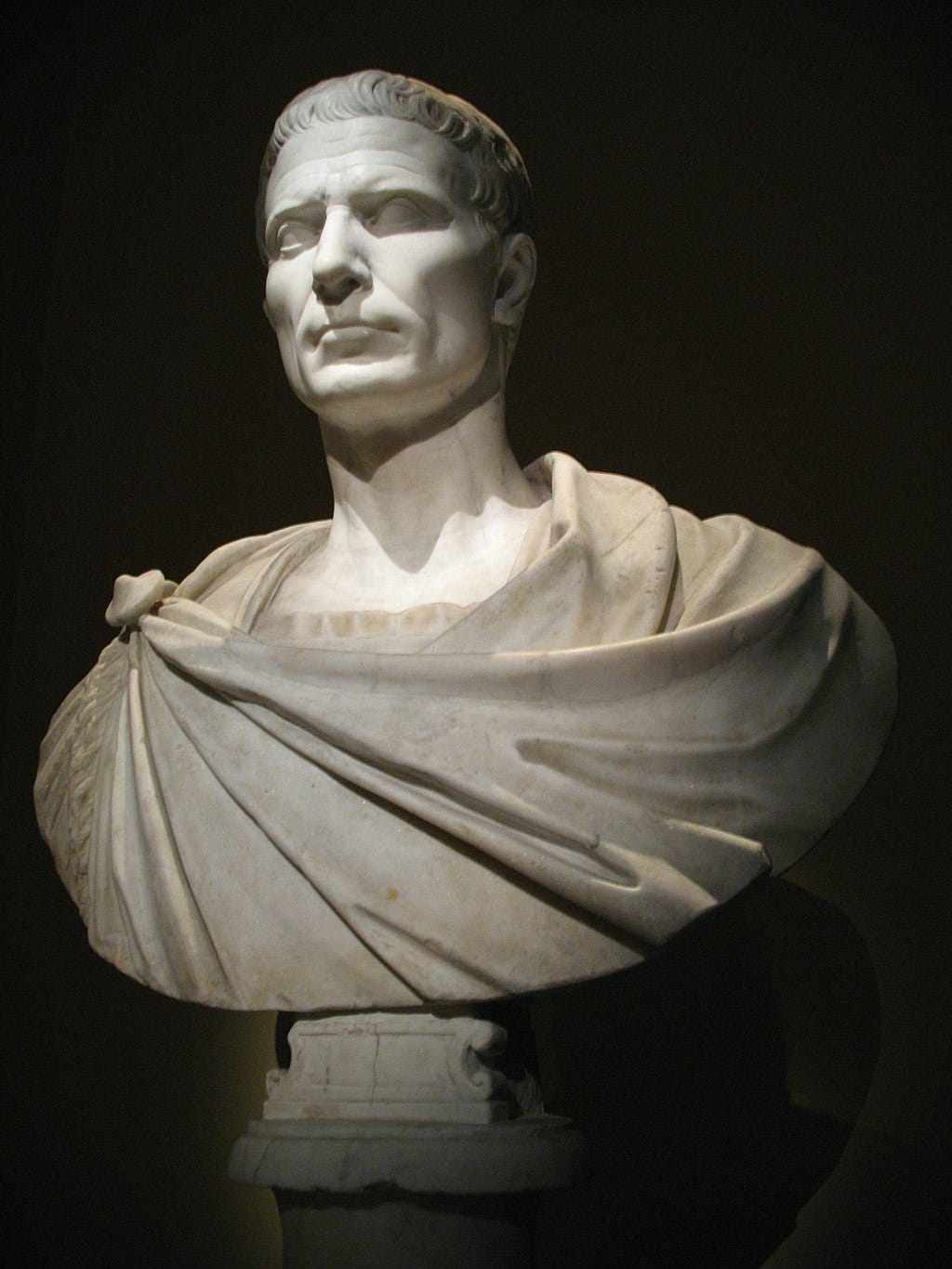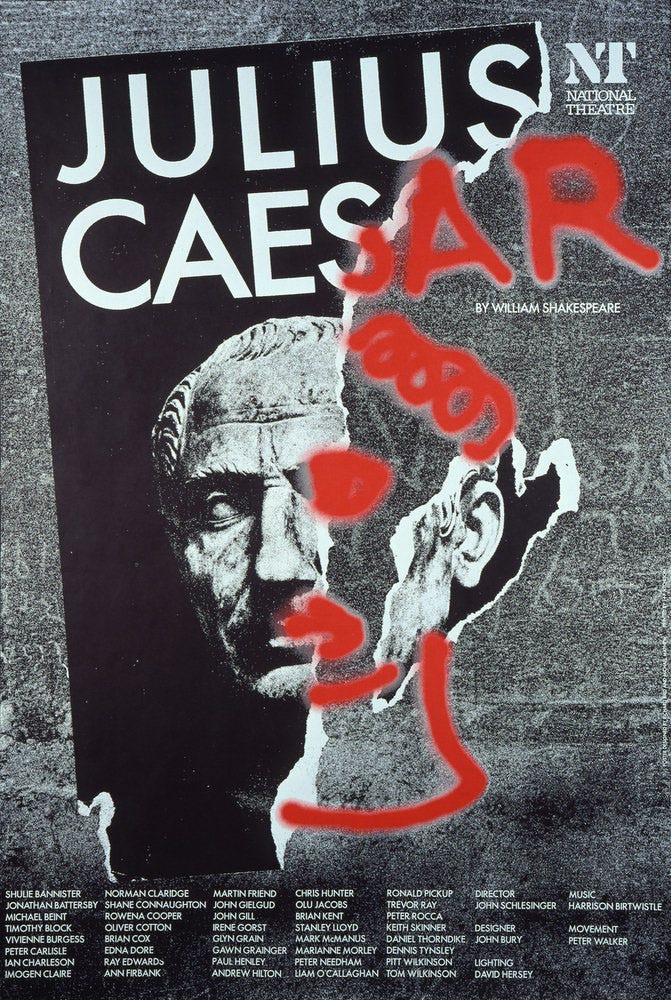The Evolution of a Poster for Shakespeare's Julius Caesar
This is an account I wrote a while back when I was making posters for a local Shakespeare company. It’s about process.

My first step in designing a theater poster is to read the play (though I must admit that in this case I watched an old BBC production of Julius Caesar, flowing with togas, breastplates, swords and spears). Then I think about ideas, and at some point in the process I look online to see what others have done, for inspiration, and so that I won't unintentionally design something that is too close to another artist's work.
My first idea for illustrating Shakespeare's Julius Caesar was to draw a bust of Caesar with a knife in its back and blood dripping down. I liked the idea of a statue that would represent the historical aspect of the play, with the bleeding as magic realism. I was particularly taken with the statue below because of the strange, troubled look on Caesar’s face, as though he knew what was coming. Or maybe he's thinking, “Et tu, Brute?”
This work seems different from other hero statues. I suspect that, usually, back in the day (and still) when a bust or statue was commissioned, the point was to Photoshop (so to speak) the subject into looking mighty fine. I don't know the history of this bust but it is a remarkably human depiction of a guy who's feeling uneasy. I love the dark stone and light eyes.
At this point I learned that the director wanted to set the play in modern times, so I revised the idea to include a business suit as part of the sculpture, which I thought would make an intriguing image and would also be fun to draw.
It's tough being Caesar, always worrying that you might get stabbed in the back. Or not worrying enough . . .
In looking around online, the only image I found with a similar theme was an excellent poster, beautifully rendered, by the renowned Scott McKowen using the strong hero statue motif with blood splatter across its face and chest.

After a conversation with the director, who felt strongly that the bust in question looked too pathetic (she wanted no sympathy for Caesar) I explored a couple of different directions. Following from the statue idea I looked at images of fallen statues, like the one below.
I thought of showing the mob as shadows, but the whole idea seemed too mixed-metaphor and confusing, so then I retained the shadows concept, and incorporated a more subtle way to show modernity (graffiti on the wall) political power (poster on the wall) and its overthrow by the mob (the ragged tear down the middle and the bloody knife on the ground). The words, “Age, thou are shamed!” are from the play.
The finished poster. The shadows look a bit too light here, but I needed to lighten them up so that the printed poster would not be too dark. I decided against blood splatter and just put blood on the knife itself. The bricks, cement, and knife are all found images in the public domain.
After my poster was finished, I looked again online, and this time I found an image that I had not seen before, which I felt was thematically related to my final design, and though I hate to admit it, even better. The use of a torn poster and graffiti that continues the image and title of the play is beautiful and brilliant, as is the subtle use of black, white and red. This poster was designed by Richard Bird and Michael Mayhew of the National Theatre, for the 1977 John Schlesinger production of Julius Caesar in the Olivier Theatre. John Gielgud played Caesar.
To see more Shakespeare theatre posters I have made, visit lamblionstudio.com/theatre-posters.

A bit more…
Yesterday, in my book called 365 Tao, I read these words:
Banish uncertainty. Affirm strength. Hold resolve. Expect death.
It’s a great formula and nice work if you can get it. I especially appreciate the ‘Expect death,’ because all that resolve and strength seems more feasible in the context of facing reality, which is to expect death (like Caesar probably didn’t).
I want this formula with all my heart. I’m old enough that now or never makes perfect sense. And yet, I don’t get anywhere by bossing myself around. Resolve, when I feel it, is a warmth in my loins. It’s an erotic relationship with life. That relationship requires as much uncertainty as certainty.
Whether it’s getting stabbed in the back (and front) by all those folks you thought were your friends, or simply being overtaken by the next set of unresolved ancestral complications arising in your psyche, no-one can banish uncertainty all the time, unless you are nuts. So even though exhortations to strength, power and determination are helpful to me, there has to be a gooey center, where I feel the vulnerability of love and suffering and compassion, for myself and others.
Your life is a creation that dies when you die. Release it, give up your individuality, and in so doing, finally merge with the Tao. Until that moment, create the poetry of your life with toughness and determination. ~365 Tao, page 125
The way I interpret this is that the poetry of life is the gooey center and the toughness and determination are the handlers, the fixers, the guys who get it done. So one of the tricks is knowing who’s boss and who isn’t. Another important trick is cutting yourself a whole lot of slack, with good humor and grace, for we are so very imperfect…









